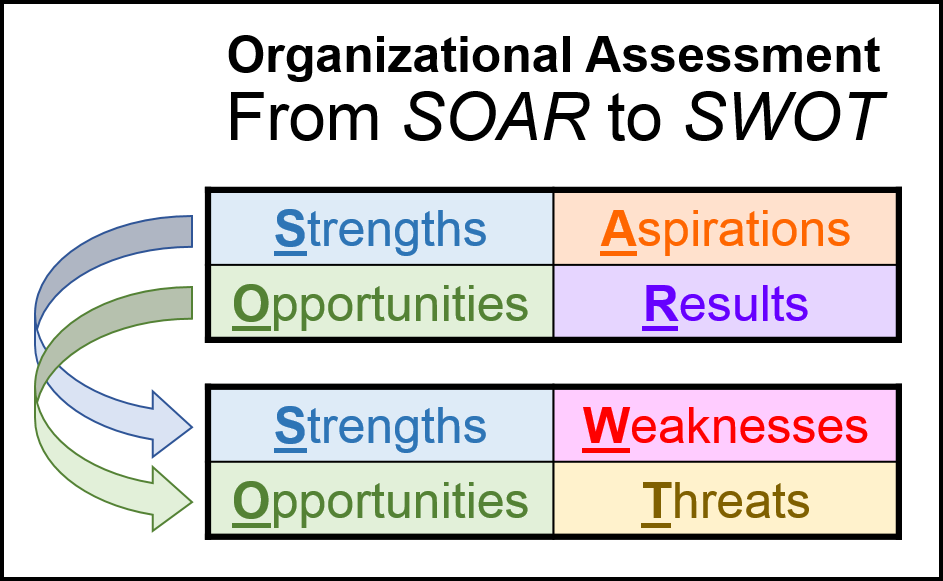Use SOAR with SWOT to Accelerate Strategy Development
In essence, strategic planning is about changing from a current state to a desired future state. The better you can understand and articulate both, the easier it is to identify the necessary changes (Strategies and Tactics) that will be needed to move from current state to future state. This is where information and analysis play such a vital role – they can deepen our knowledge of not only the way things are now, but also what they could be like. But at some point, the information and analysis relevant to both the current and future state must be mined for key findings. There are different techniques for doing this, but two in particular work very well. They have an added advantage in that they have short learning curves, making them ideal for use in the Committees, Task Forces, and Work Groups often charged with developing a particular strategy or plan. In fact, you may already be familiar with one of them.
Understanding the “Current State”: Many people are familiar with a SWOT Analysis. SWOT is an acronym that stands for Strengths, Weaknesses, Opportunities, and Threats. Participants brainstorm observations, share insights, or identify relevant findings under each of these headings, usually in the same sequence as the acronym. There are some other nuances that contribute to a good outcome, but essentially the SWOT Analysis provides a framework for assessing current state or where an organization is at the present time. It can easily serve as the foundation of an Organizational Assessment.
Envisioning the “Ideal Future State”: Even though a SWOT Analysis includes opportunities and threats, which could be seen as somewhat future-oriented, their purpose in SWOT is to surface growth potential and vulnerabilities in the organization at the present time. For this reason, the SWOT Analysis has limited value as a tool for developing a Desired Future State. That’s where another tool, less familiar to most but similar in design, can help. A SOAR Analysis focuses on four aspects, two of which are shared with a SWOT Analysis: Strengths, Opportunities, Aspirations, and Results. Again, there are nuances to completing a SOAR Analysis but essentially the participants identify the observations, insights and findings that help define the desired future state, or what success will be like.
 Tapping the Power of Two: The two techniques can be, and often are, used separately. Many use SWOT Analysis alone to dissect a problem or challenge. SOAR Analysis can be an effective way to establish an Aim Statement or new Team Charter. However, because the essence of planning is clarifying both the current and future state, they can be used as two parts of the same planning process. And, when this is done, some additional efficiencies are gained. Having addressing the Strengths and Opportunities as part of a SOAR analysis in the vision / goals development, they can be simply imported into a SWOT Analysis, meaning almost half the work of the SWOT Analysis is already complete. And for the participants, the shared content of Strengths and Opportunities creates a logical, mental connection between current and future state.
Tapping the Power of Two: The two techniques can be, and often are, used separately. Many use SWOT Analysis alone to dissect a problem or challenge. SOAR Analysis can be an effective way to establish an Aim Statement or new Team Charter. However, because the essence of planning is clarifying both the current and future state, they can be used as two parts of the same planning process. And, when this is done, some additional efficiencies are gained. Having addressing the Strengths and Opportunities as part of a SOAR analysis in the vision / goals development, they can be simply imported into a SWOT Analysis, meaning almost half the work of the SWOT Analysis is already complete. And for the participants, the shared content of Strengths and Opportunities creates a logical, mental connection between current and future state.
Building “Bridges” with Solid Anchoring: The planning team can now proceed with identifying the “bridges” of change needed to move from current to future state. And, they can do so knowing that at either end of the bridges, they have solid anchoring in the form of an insightful current state at one end, and a well-conceived desired future state at the other.
If you want help using SWOT and SOAR Analysis in the development of your strategy or Strategic Plan, or if I can be of other assistance, just contact me at your convenience.
Jeff
